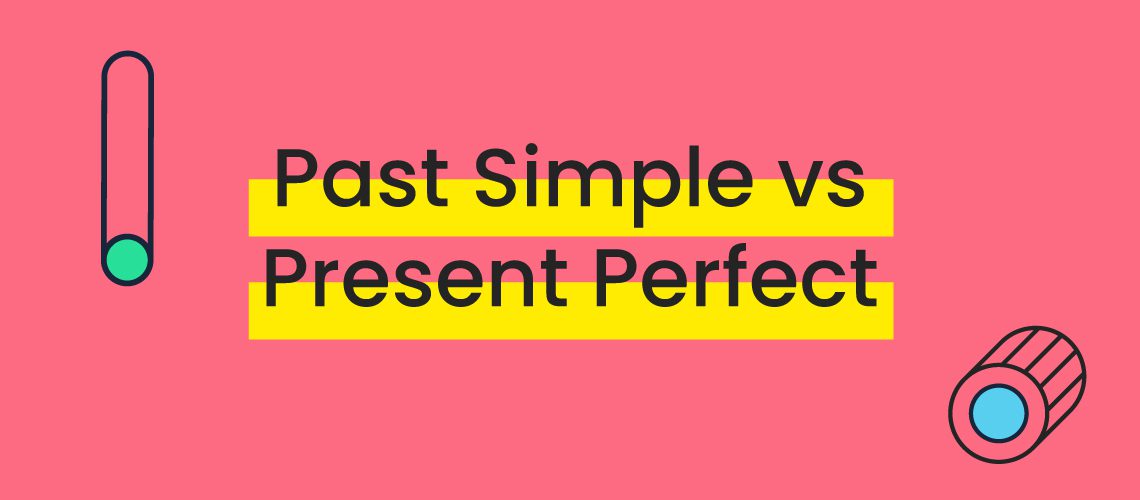
The assortment of verb tenses that the English language uses can be very challenging and frustrating for English-learners to understand. If you’re not so familiar with grammar, a verb tense refers to the point or period in time during which an action takes place.
In English, there are twelve basic verb tenses as well as additional variations that apply to some of them. While native speakers of English simply know when it’s correct to use a particular tense and do so naturally, a non-native speaker may find it far more difficult to learn the nuances. One of the most common confusions about these tenses is the distinction between the past simple and the present perfect verb tenses.
The quickest way to make sense of these two tenses is to understand actions as either definite actions that started and finished in the past, or actions that started in the past and have a continuity that affects the present.
We can visualize the past simple and present perfect as features of geometry. The past simple is used for past actions that:
– started and finished
– are over and done with
– began and ended
– opened and then closed indefinitely
In mathematical terms, a past simple action is like a line segment with a starting point and an ending point, existing in the space of the past. On the other hand, a present perfect action is more like a geometrical ray— it has a starting point in the past and stretches onward to the present like an arrow with no end point. The present perfect is used for actions that began in the past and continue into and bear meaning in the present.

Now that we have a defined and conceptual image of how these verb tenses function, how do we use them?
Let’s begin with past simple. Once again, the past simple verb tense is used for actions that occurred in the past and have a definite beginning and ending point with no connection to the present. For example:
“My sister ran a small business.”
“He ordered 40 pallets.”
“My colleague sent the email but missed their reply.”
These cases all describe things that began and ended in the past. Additionally, past simple actions are also frequently accompanied by a word or phrase that indicates a sense of time. For example:
“The CEO made a drastic decision today.”
“My client won a deal yesterday.”
“Last week, we saw the team.”
“Gav did not attend today.”
“I did not achieve my goals last quarter.”
These time-related words and phrases indicate a period or point in time that has passed, and the action that occurred is contained and closed within that space.
Alternatively, the present perfect is used to refer to actions that began at some point in the past that also remain relevant and connected to the present. Perfect present constructions combine present tense conjugations of the verb “to have” (I/you/we/they have, he/she/it has) with an action in the form of something called a past participle.
For many verbs, this participle is often the past tense form of an action, where an “-ed” suffix is added to the end of the word, like when “walk” becomes “walked.”
However, it is important to understand that a past participle and a past-tense form of a verb are different parts of speech and therefore do not always appear as same words (for example, “saw” is the past tense of “see,” but “seen” is the participle). There are irregular cases and exceptions for some participles that simply require memorization, but this topic is complex enough to become a separate grammar lesson.
For example:
“Ryan has spoken to large audiences.”
“Yaniv and Ronen have gone scouting.”
“Inbar has not shared her references.”
“Dana and Keren have not passed their aptitude tests.”
As we have established, perfect present statements are used to express actions that started in the past, but still have a bearing on the present and are not confined to a closed segment of time. Present perfect statements often qualify a subject with an experience.
Let’s take this past simple sentence:
“The new hire saw the base salary.”
If we want to qualify the new hire with the experience of seeing the base salary, we can change the sentence to the present perfect form:
“The new hire has seen the base salary.” (Note the use of seen instead of saw.)
In this sentence, it’s implied that the new hire saw the base salary in the past, and it connects the action of seeing the base salary to the present— the present new hire now possesses the experience of having seen the base salary.
Now let’s consider the sentence:
“Aria has been to WeWork.”
This sentence gives us information about both the past and present. We know that Aria went to WeWork in the past, but this action also becomes a qualification connected to Aria in the present.
Furthermore, present perfect constructions are only used to express things that are true to the present. Unlike the past simple, the present perfect cannot be used with past time phrases.
For example, you would not say:
“Yesterday, I have been to that location.”
This is incorrect. This is because “yesterday” is a period of time that has already passed, but the statement “I have” is in the present. You cannot be in the past and present at the same time. If the timing of the action needs to be specified, you must express this thought in the past simple structure:
“Yesterday, I went to that location.”
Past simple and present perfect both allow us to talk about the past. However, we use the past simple for actions that started, ended, and are definite and contained in the past.
Present perfect is used for past actions that are connected to the present. If you’re still learning English, you may find it tricky to grasp the difference, but with Uptick’s Fluency Formula, you will soon be able to make the distinction on your own, more naturally. We cover all the bases and more including grammar, vocabulary, pronunciation, and fluency!








